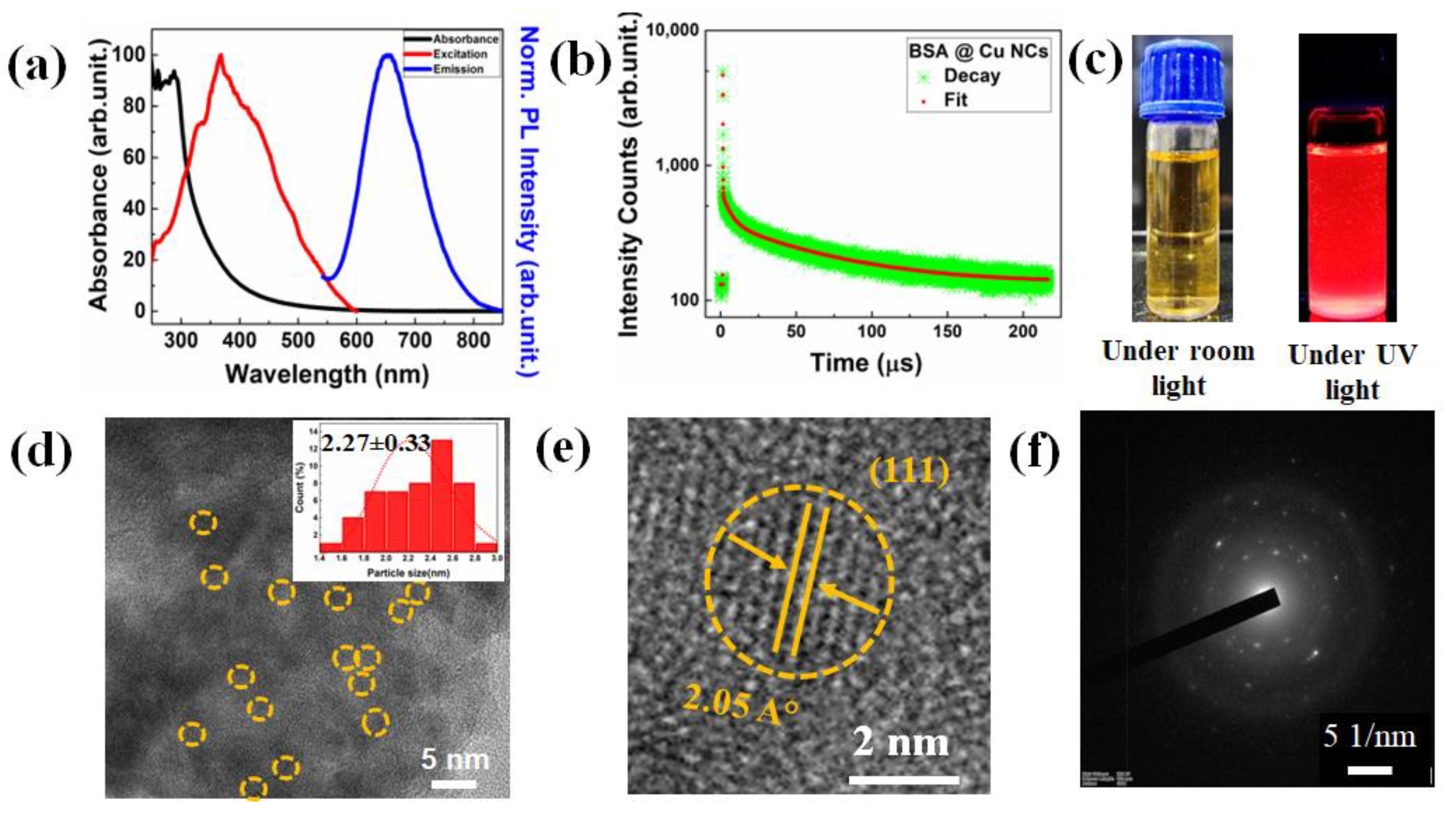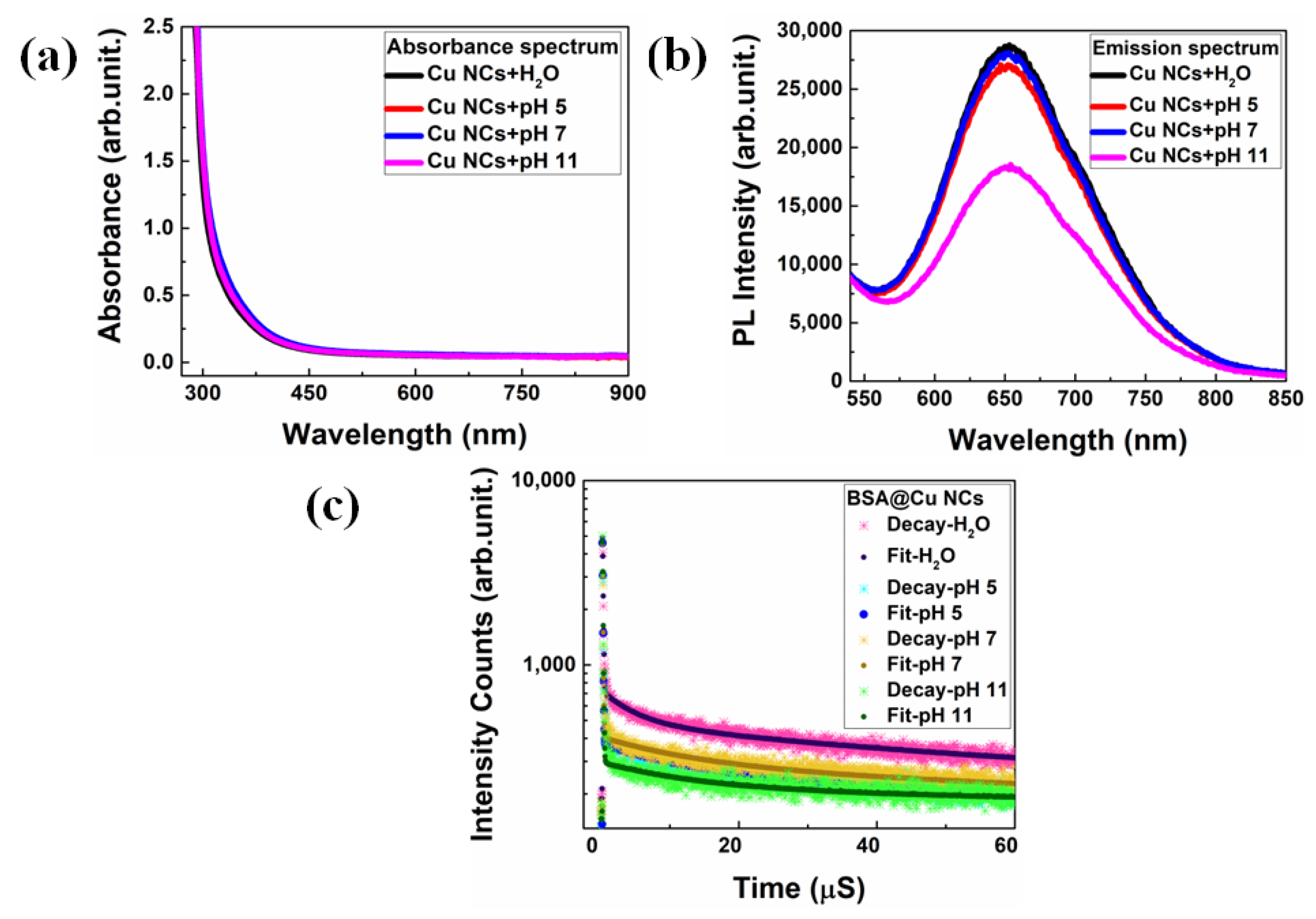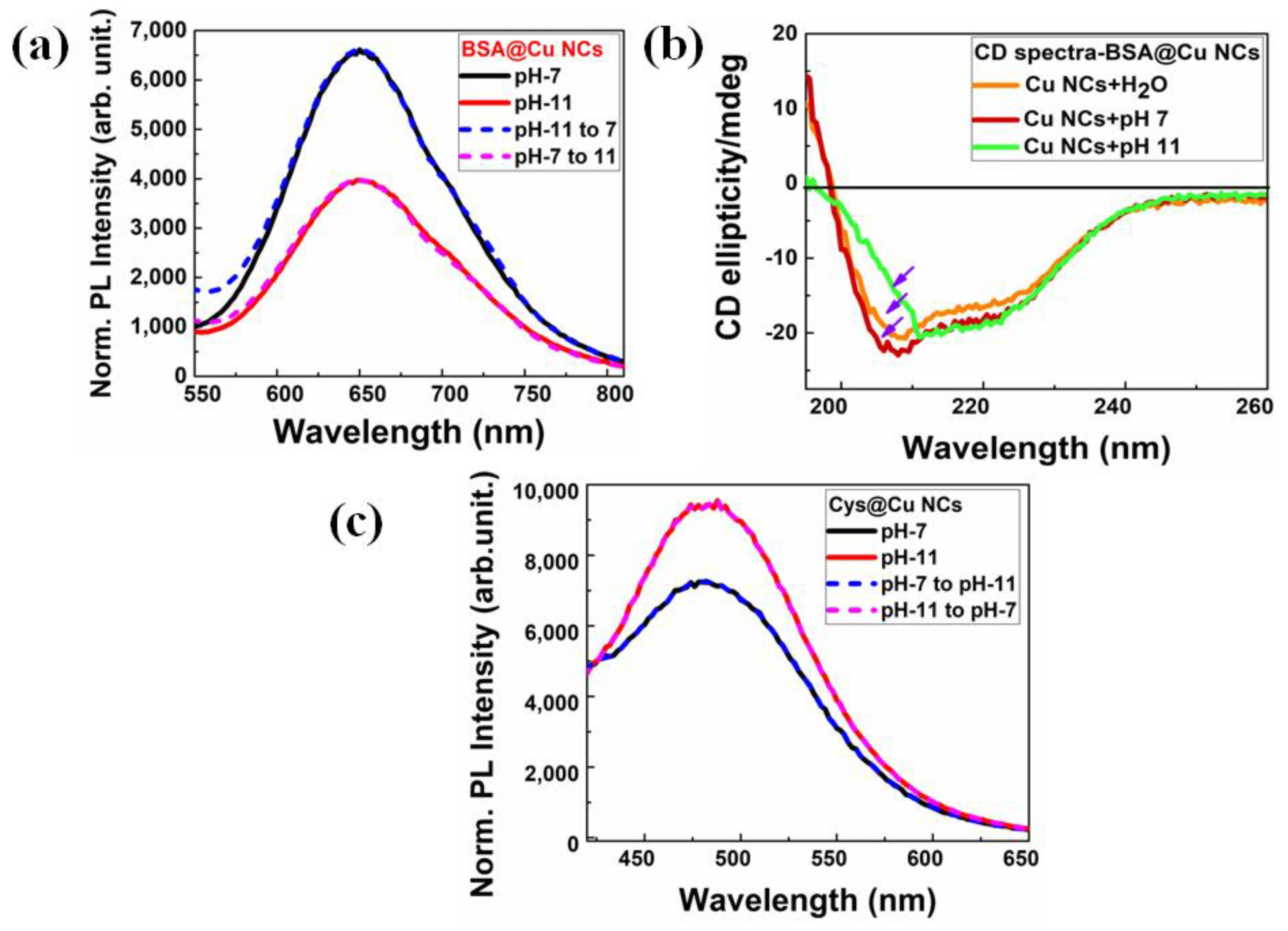Surface Ligand Influences the Cu Nanoclusters as a Dual Sensing Optical Probe for Localized pH Environment and Fluoride Ion
Abstract
1. Introduction
2. Materials and Methods
2.1. Reagents and Chemicals
2.2. Methods for Fabrication
2.2.1. Synthesis of Red-Emitting BSA-Cu NCs
2.2.2. Synthesis of Green-Emitting L-Cysteine-Cu NCs
2.2.3. Preparation of Buffer Solution
2.2.4. Detection of Fluoride Ion
2.3. Measurements and Characterizations
3. Results and Discussions
3.1. Design of BSA-Cu NCs as Biosensor
3.2. Effect of pH on the Fluorescence Properties of BSA-Cu NCs
3.3. Cu NCs as Versatile pH Sensor
3.4. Anion Selectivity Test
3.5. Fluoride Ion Detection of Cu NCs
4. Conclusions
Supplementary Materials
Author Contributions
Funding
Institutional Review Board Statement
Informed Consent Statement
Data Availability Statement
Acknowledgments
Conflicts of Interest
References
- Matus, M.F.; Häkkinen, H. Atomically Precise Gold Nanoclusters: Towards an Optimal Biocompatible System from a Theoretical–Experimental Strategy. Small 2021, 17, 2005499. [Google Scholar] [CrossRef] [PubMed]
- Tao, Y.; Li, M.; Ren, J.; Qu, X. Metal nanoclusters: Novel probes for diagnostic and therapeutic applications. Chem. Soc. Rev. 2015, 44, 8636–8663. [Google Scholar] [CrossRef]
- Song, X.R.; Goswami, N.; Yang, H.H.; Xie, J. Functionalization of metal nanoclusters for biomedical applications. Analyst 2016, 141, 3126–3140. [Google Scholar] [CrossRef]
- Zhao, Y.; Zhou, H.; Zhang, S.; Xu, J. The synthesis of metal nanoclusters and their applications in bio-sensing and imaging. Methods Appl. Fluoresc. 2019, 8, 012001. [Google Scholar] [CrossRef] [PubMed]
- Zheng, K.; Xie, J. Engineering Ultrasmall Metal Nanoclusters as Promising Theranostic Agents. Trends Chem. 2020, 2, 665–679. [Google Scholar] [CrossRef]
- Lai, W.F.; Wong, W.T.; Rogach, A.L. Development of Copper Nanoclusters for In Vitro and In Vivo Theranostic Applications. Adv. Mater. 2020, 32, 1906872. [Google Scholar] [CrossRef] [PubMed]
- Jin, R.; Zeng, C.; Zhou, M.; Chen, Y. Atomically Precise Colloidal Metal Nanoclusters and Nanoparticles: Fundamentals and Opportunities. Chem. Rev. 2016, 116, 10346–10413. [Google Scholar] [CrossRef]
- Mathew, A.; Pradeep, T. Noble metal clusters: Applications in energy, environment, and biology. Part. Part. Syst. Charact. 2014, 31, 1017–1053. [Google Scholar] [CrossRef]
- Li, D.; Chen, Z.; Mei, X. Fluorescence enhancement for noble metal nanoclusters. Adv. Colloid Interface Sci. 2017, 250, 25–39. [Google Scholar] [CrossRef] [PubMed]
- Busi, K.B.; Palanivel, M.; Ghosh, K.K.; Ball, W.B.; Gulyás, B.; Padmanabhan, P.; Chakrabortty, S. The Multifarious Applications of Copper Nanoclusters in Biosensing and Bioimaging and Their Translational Role in Early Disease Detection. Nanomaterials 2022, 12, 301. [Google Scholar] [CrossRef]
- Higaki, T.; Li, Q.; Zhou, M.; Zhao, S.; Li, Y.; Li, S.; Jin, R. Toward the Tailoring Chemistry of Metal Nanoclusters for Enhancing Functionalities. Acc. Chem. Res. 2018, 51, 2764–2773. [Google Scholar] [CrossRef] [PubMed]
- Lin, Z.; Goswami, N.; Xue, T.; Chai, O.J.H.; Xu, H.; Liu, Y.; Su, Y.; Xie, J. Engineering Metal Nanoclusters for Targeted Therapeutics: From Targeting Strategies to Therapeutic Applications. Adv. Funct. Mater. 2021, 31, 2105662. [Google Scholar] [CrossRef]
- Loynachan, C.N.; Soleimany, A.P.; Dudani, J.S.; Lin, Y.; Najer, A.; Bekdemir, A.; Chen, Q.; Bhatia, S.N.; Stevens, M.M. Renal clearable catalytic gold nanoclusters for in vivo disease monitoring. Nat. Nanotechnol. 2019, 14, 883–890. [Google Scholar] [CrossRef] [PubMed]
- Yang, J.; Jin, R. New Advances in Atomically Precise Silver Nanoclusters. ACS Mater. Lett. 2019, 1, 482–489. [Google Scholar] [CrossRef]
- Singh, R.; Majhi, S.; Sharma, K.; Ali, M.; Sharma, S.; Choudhary, D.; Tripathi, C.S.P.; Guin, D. BSA stabilized copper nanoclusters as a highly sensitive and selective probe for fluorescence sensing of Fe3+ ions. Chem. Phys. Lett. 2021, 787, 139226. [Google Scholar] [CrossRef]
- Shahsavari, S.; Hadian-Ghazvini, S.; Saboor, F.H.; Oskouie, I.M.; Hasany, M.; Simchi, A.; Rogach, A.L. Ligand functionalized copper nanoclusters for versatile applications in catalysis, sensing, bioimaging, and optoelectronics. Mater. Chem. Front. 2019, 3, 2326–2356. [Google Scholar] [CrossRef]
- Zare, I.; Chevrier, D.M.; Cifuentes-Rius, A.; Moradi, N.; Xianyu, Y.; Ghosh, S.; Trapiella-Alfonso, L.; Tian, Y.; Shourangiz-Haghighi, A.; Mukherjee, S.; et al. Protein-protected metal nanoclusters as diagnostic and therapeutic platforms for biomedical applications. Mater. Today 2021, 42. [Google Scholar] [CrossRef]
- Hu, X.; Liu, T.; Zhuang, Y.; Wang, W.; Li, Y.; Fan, W.; Huang, Y. Recent advances in the analytical applications of copper nanoclusters. TrAC—Trends Anal. Chem. 2016, 77, 66–75. [Google Scholar] [CrossRef]
- Qing, T.; Zhang, K.; Qing, Z.; Wang, X.; Long, C.; Zhang, P.; Hu, H.; Feng, B. Recent progress in copper nanocluster-based fluorescent probing: A review. Microchim. Acta 2019, 186, 670. [Google Scholar] [CrossRef]
- Zhou, Y.; Zhang, J.F.; Yoon, J. Fluorescence and colorimetric chemosensors for fluoride-ion detection. Chem. Rev. 2014, 114, 5511–5571. [Google Scholar] [CrossRef]
- Yan, W.; Zhang, J.; Abbas, M.; Li, Y.; Hussain, S.Z.; Mumtaz, S.; Song, Z.; Hussain, I.; Tan, B. Facile Synthesis of Ultrastable Fluorescent Copper Nanoclusters and Their Cellular Imaging Application. Nanomaterials 2020, 10, 1678. [Google Scholar] [CrossRef]
- Chandran, N.; Janardhanan, P.; Bayal, M.; Unniyampurath, U.; Pilankatta, R.; Nair, S.S. Label Free, Nontoxic Cu-GSH NCs as a Nanoplatform for Cancer Cell Imaging and Subcellular pH Monitoring Modulated by a Specific Inhibitor: Bafilomycin A1. ACS Appl. Bio. Mater. 2020, 3, 1245–1257. [Google Scholar] [CrossRef] [PubMed]
- Cai, Z.; Zhang, C.; Jia, K. l-Tyrosine protected Cu nanoclusters for reversible pH-sensors. Chem. Pap. 2020, 74, 1831–1838. [Google Scholar] [CrossRef]
- Liu, S.; Zhang, X.; Yan, C.; Zhou, P.; Zhang, L.; Li, Q.; Zhang, R.; Chen, L.; Zhang, L. A small molecule flurescent probe for mercury ion analysis in broad low pH range: Spectral, optical mechanism and application studies. J. Hazard. Mater. 2022, 424, 127701. [Google Scholar] [CrossRef]
- Yin, H.; Zhao, B.; Kan, W.; Ding, L.; Wang, L.; Song, B.; Wang, W.; Deng, Q. A phenanthro[9,10-d]imidazole-based optical sensor for dual-responsive turn-on detection of acidic pH and Cu2+ in chicken blood and living cells. Dyes Pigments 2020, 173, 107916. [Google Scholar] [CrossRef]
- Martinière, A.; Gibrat, R.; Sentenac, H.; Dumont, X.; Gaillard, I.; Paris, N. Uncovering pH at both sides of the root plasma membrane interface using noninvasive imaging. Proc. Natl. Acad. Sci. USA 2018, 115, 6488–6493. [Google Scholar] [CrossRef]
- Gjetting, K.S.; Ytting, K.C.; Schulz, A.; Fuglsang, A. Live imaging of intra- and extracellular pH in plants using pHusion, a novel genetically encoded biosensor. J. Exp. Bot. 2012, 63, 3207–3218. [Google Scholar] [CrossRef]
- Steinegger, A.; Wolfbies, O.S.; Borisov, S.M. Optical Sensing and Imaging of pH Values: Spectroscopies, Materials, and Applications. Chem. Rev. 2020, 120, 12357–12489. [Google Scholar] [CrossRef] [PubMed]
- An, Y.; Ren, Y.; Bick, M.; Dudek, A.; Waworuntu, E.H.-W.; Tang, J.; Chen, J.; Chang, B. Highly fluorescent copper nanoclusters for sensing and bioimaging. Biosens. Bioelectron. 2020, 154, 112078. [Google Scholar] [CrossRef]
- Zhou, M.; Tian, M.; Li, C. Copper-Based Nanomaterials for Cancer Imaging and Therapy. Bioconjug. Chem. 2016, 27, 1188–1199. [Google Scholar] [CrossRef]
- Heo, G.S.; Zhao, Y.; Sultan, D.; Zhang, X.; Detering, L.; Luehmann, H.P.; Zhang, X.; Li, R.; Choksi, A.; Sharp, S.; et al. Assessment of Copper Nanoclusters for Accurate in Vivo Tumor Imaging and Potential for Translation. ACS Appl. Mater. Interfaces 2019, 11, 19669–19678. [Google Scholar] [CrossRef] [PubMed]
- Zhang, X.H.; Zhou, T.Y.; Chen, X. Applications of metal nanoclusters in environmental monitoring. Chin. J. Anal. Chem. 2015, 43, 1296–1305. [Google Scholar] [CrossRef]
- Udhayakumari, D. Detection of toxic fluoride ion via chromogenic and fluorogenic sensing. A comprehensive review of the year 2015–2019. Spectrochim. Acta Part A Mol. Biomol. Spectrosc. 2020, 228, 117817. [Google Scholar] [CrossRef] [PubMed]
- Lin, Q.; Gong, G.F.; Fan, Y.Q.; Chen, Y.Y.; Wang, J.; Guan, X.W.; Liu, J.; Zhang, Y.M.; Yao, H.; Wei, T.B. Anion induced supramolecular polymerization: A novel approach for the ultrasensitive detection and separation of F−. Chem. Commun. 2019, 55, 3247–3250. [Google Scholar] [CrossRef]
- Srivastava, S.; Flora, S.J.S. Fluoride in Drinking Water and Skeletal Fluorosis: A Review of the Global Impact. Curr. Environ. Health Rep. 2020, 7, 140–146. [Google Scholar] [CrossRef]
- Boxi, S.S.; Paria, S. Fluorometric selective detection of fluoride ions in aqueous media using Ag doped CdS/ZnS core/shell nanoparticles. Dalton Trans. 2016, 45, 811–819. [Google Scholar] [CrossRef] [PubMed]
- Wu, Y.; Chakrabortty, S.; Gropeanu, R.A.; Wilhelmi, J.; Xu, Y.; Shih Er, K.; Ling Kuan, S.; Koynov, K.; Chan, Y.; Weil, T. pH-Responsive Quantum Dots via an Albumin Polymer Surface Coating. J. Am. Chem. Soc. 2010, 132, 5012–5014. [Google Scholar] [CrossRef] [PubMed]
- Nawade, A.; Busi, K.B.; Ramya, K.; Dalapati, G.K.; Mukhopadhyay, S.; Chakrabortty, S. Improved Charge Transport across Bovine Serum Albumin–Au Nanoclusters’ Hybrid Molecular Junction. ACS Omega 2022, 7, 20906–20913. [Google Scholar] [CrossRef] [PubMed]
- Busi, K.B.; Kotha, J.; Bandaru, S.; Ghantasala, J.P.; Haseena, S.; Bhamidipati, K.; Puvvada, N.; Ravva, M.K.; Thondamal, M.; Chakrabortty, S. Engineering colloidally stable, highly fluorescent and nontoxic Cu nanoclusters via reaction parameter optimization. RSC Adv. 2022, 12, 17585–17595. [Google Scholar] [CrossRef] [PubMed]
- Bhunia, S.; Kumar, S.; Purkayastha, P. Application of Photoinduced Electron Transfer with Copper Nanoclusters toward Finding Characteristics of Protein Pockets. ACS Omega 2019, 4, 2523–2532. [Google Scholar] [CrossRef]
- Wang, C.; Wang, C.; Xu, L.; Cheng, H.; Lin, Q.; Zhang, C. Protein-directed synthesis of pH-responsive red fluorescent copper nanoclusters and their applications in cellular imaging and catalysis. Nanoscale 2014, 6, 1775–1781. [Google Scholar] [CrossRef]
- Goswami, N.; Giri, A.; Bootharaju, M.S.; Xavier, P.L.; Pradeep, T.; Pal, S.K. Copper quantum clusters in protein matrix: Potential sensor of Pb2+ ion. Anal. Chem. 2011, 83, 9676–9680. [Google Scholar] [CrossRef] [PubMed]
- Maity, S.; Bain, D.; Chakraborty, S.; Kolay, S.; Patra, A. Copper Nanocluster (Cu23 NC)-Based Biomimetic System with Peroxidase Activity. ACS Sustain. Chem. Eng. 2020, 8, 18335–18344. [Google Scholar] [CrossRef]
- Baghdasaryan, A.; Bürgi, T. Copper nanoclusters: Designed synthesis, structural diversity, and multiplatform applications. Nanoscale 2021, 13, 6283–6340. [Google Scholar] [CrossRef]
- Xie, J.; Zheng, Y.; Ying, J.Y. Protein-directed synthesis of highly fluorescent gold nanoclusters. J. Am. Chem. Soc. 2009, 131, 888–889. [Google Scholar] [CrossRef]
- Yang, T.Q.; Peng, B.; Shan, B.Q.; Zong, Y.X.; Jiang, J.G.; Wu, P.; Zhang, K. Origin of the photoluminescence of metal nanoclusters: From metal-centered emission to ligand-centered emission. Nanomaterials 2020, 10, 261. [Google Scholar] [CrossRef]
- Fehér, B.; Lyngsø, J.; Bartók, B.; Mihály, J.; Varga, Z.; Mészáros, R.; Pedersen, J.S.; Bóta, A.; Varga, I. Effect of pH on the conformation of bovine serume albumin—Gold bioconjugates. J. Mol. Liq. 2020, 309, 113065. [Google Scholar] [CrossRef]
- Zhao, J.; Wang, Z.; Lu, Y.; Li, H.; Guan, Y.; Huang, W.; Liu, Y. Facile and rapid synthesis of copper nanoclusters as a fluorescent probe for the sensitive detection of fluoride ions with the assistance of aluminum. Dyes Pigments 2022, 206, 110593. [Google Scholar] [CrossRef]
- Pang, J.; Lu, Y.; Gao, X.; He, L.; Sun, J.; Yang, F.; Hao, Z.; Liu, Y. DNA-templated copper nanoclusters as a fluorescent probe for fluoride by using aluminum ions as a bridge. Microchim. Acta 2019, 186, 364. [Google Scholar] [CrossRef] [PubMed]






Disclaimer/Publisher’s Note: The statements, opinions and data contained in all publications are solely those of the individual author(s) and contributor(s) and not of MDPI and/or the editor(s). MDPI and/or the editor(s) disclaim responsibility for any injury to people or property resulting from any ideas, methods, instructions or products referred to in the content. |
© 2023 by the authors. Licensee MDPI, Basel, Switzerland. This article is an open access article distributed under the terms and conditions of the Creative Commons Attribution (CC BY) license (https://creativecommons.org/licenses/by/4.0/).
Share and Cite
Busi, K.B.; Das, S.; Palanivel, M.; Ghosh, K.K.; Gulyás, B.; Padmanabhan, P.; Chakrabortty, S. Surface Ligand Influences the Cu Nanoclusters as a Dual Sensing Optical Probe for Localized pH Environment and Fluoride Ion. Nanomaterials 2023, 13, 529. https://doi.org/10.3390/nano13030529
Busi KB, Das S, Palanivel M, Ghosh KK, Gulyás B, Padmanabhan P, Chakrabortty S. Surface Ligand Influences the Cu Nanoclusters as a Dual Sensing Optical Probe for Localized pH Environment and Fluoride Ion. Nanomaterials. 2023; 13(3):529. https://doi.org/10.3390/nano13030529
Chicago/Turabian StyleBusi, Kumar Babu, Subhalaxmi Das, Mathangi Palanivel, Krishna Kanta Ghosh, Balázs Gulyás, Parasuraman Padmanabhan, and Sabyasachi Chakrabortty. 2023. "Surface Ligand Influences the Cu Nanoclusters as a Dual Sensing Optical Probe for Localized pH Environment and Fluoride Ion" Nanomaterials 13, no. 3: 529. https://doi.org/10.3390/nano13030529
APA StyleBusi, K. B., Das, S., Palanivel, M., Ghosh, K. K., Gulyás, B., Padmanabhan, P., & Chakrabortty, S. (2023). Surface Ligand Influences the Cu Nanoclusters as a Dual Sensing Optical Probe for Localized pH Environment and Fluoride Ion. Nanomaterials, 13(3), 529. https://doi.org/10.3390/nano13030529







